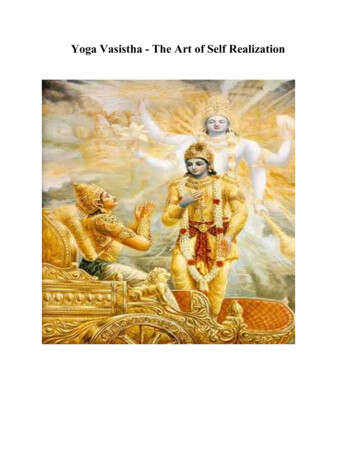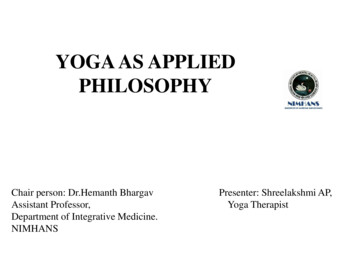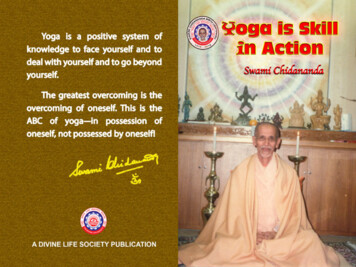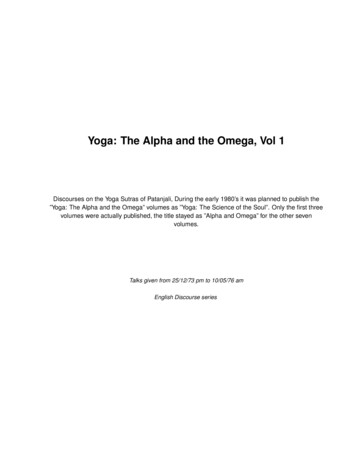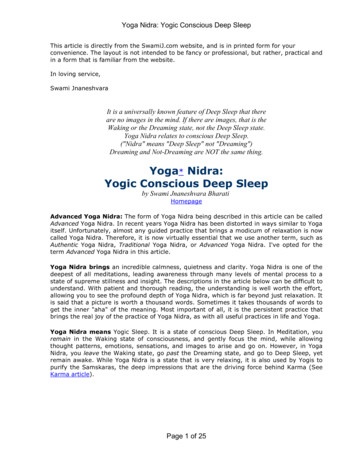
Transcription
Yoga Nidra: Yogic Conscious Deep SleepThis article is directly from the SwamiJ.com website, and is in printed form for yourconvenience. The layout is not intended to be fancy or professional, but rather, practical andin a form that is familiar from the website.In loving service,Swami JnaneshvaraIt is a universally known feature of Deep Sleep that thereare no images in the mind. If there are images, that is theWaking or the Dreaming state, not the Deep Sleep state.Yoga Nidra relates to conscious Deep Sleep.("Nidra" means "Deep Sleep" not "Dreaming")Dreaming and Not-Dreaming are NOT the same thing.Yoga* Nidra:Yogic Conscious Deep Sleepby Swami Jnaneshvara BharatiHomepageAdvanced Yoga Nidra: The form of Yoga Nidra being described in this article can be calledAdvanced Yoga Nidra. In recent years Yoga Nidra has been distorted in ways similar to Yogaitself. Unfortunately, almost any guided practice that brings a modicum of relaxation is nowcalled Yoga Nidra. Therefore, it is now virtually essential that we use another term, such asAuthentic Yoga Nidra, Traditional Yoga Nidra, or Advanced Yoga Nidra. I've opted for theterm Advanced Yoga Nidra in this article.Yoga Nidra brings an incredible calmness, quietness and clarity. Yoga Nidra is one of thedeepest of all meditations, leading awareness through many levels of mental process to astate of supreme stillness and insight. The descriptions in the article below can be difficult tounderstand. With patient and thorough reading, the understanding is well worth the effort,allowing you to see the profound depth of Yoga Nidra, which is far beyond just relaxation. Itis said that a picture is worth a thousand words. Sometimes it takes thousands of words toget the inner "aha" of the meaning. Most important of all, it is the persistent practice thatbrings the real joy of the practice of Yoga Nidra, as with all useful practices in life and Yoga.Yoga Nidra means Yogic Sleep. It is a state of conscious Deep Sleep. In Meditation, youremain in the Waking state of consciousness, and gently focus the mind, while allowingthought patterns, emotions, sensations, and images to arise and go on. However, in YogaNidra, you leave the Waking state, go past the Dreaming state, and go to Deep Sleep, yetremain awake. While Yoga Nidra is a state that is very relaxing, it is also used by Yogis topurify the Samskaras, the deep impressions that are the driving force behind Karma (SeeKarma article).Page 1 of 25
Yoga Nidra: Yogic Conscious Deep Sleep(Yoga Nidra practice methods are linked below)Intro Track of CD plus video: This file contains theaudio of the Introduction track of the Yoga Nidra CD. Itexplains the process of Yoga Nidra and the guidedpractices on the CD (The guided practice itself is on theother tracks of the CD). This video file also hasgraphics to help explain the audio narration.8-minutesIntro Track of CD: Listen to the Introduction track(same sound as above) of the Yoga Nidra CD, whichexplains the process of Yoga Nidra and the guidedpractices on the CD (The guided practice itself is on theother tracks of the CD).7-minutesYoga Meditation Visualized: This 7-minute videosummarizes the process of Yoga Meditation, which isextremely thorough and deep. It includes Yoga Nidraand how authentic Yoga Nidra fits into the overallprocess of Yoga Meditation.7-minutesYoga Nidra has been known for thousands of years by the sages and yogis. Of the threestates of consciousness of Waking, Dreaming and Deep Sleep, as expounded in theUpanishads, particularly the Mandukya Upanishad, Yoga Nidra refers to the consciousawareness of the Deep Sleep state, referred to as prajna in Mandukya Upanishad. This isthe third of the four levels of consciousness of AUM mantra, relating to the staterepresented by the M of AUM. The four states are Waking, Dreaming, sleep, and turiya, thefourth state. The state of Yoga Nidra, conscious Deep Sleep, is beyond or subtler than theimagery and mental process of the Waking and Dreaming states. As a state of consciousDeep Sleep, Yoga Nidra is a universal principle, and is not the exclusive domain of any morerecent teachers or traditions.In Yoga Nidra, you leave the Waking state,go through the Dreaming state,and into the Deep Sleep state,yet remain fully awake.Contents of this web page:Yoga Nidra and MeditationHow consciousness recedesNot Yoga NidraPage 2 of 25
Yoga Nidra: Yogic Conscious Deep SleepBrain waves are at DeltaParachuting and Yoga NidraPurifying samskaras, deep habit patternsLike the backdrop of a stageEmptying processDestination, not the journeyChakras and Yoga NidraTantra and the three levelsMethods are many, and simpleMethods of practicing Yoga NidraYoga Nidra begins to come naturallySee also these articles:5 Yoga Nidra method 1 2 3 4 5OM and the Seven Levels of Consciousness4 Levels and 3 Domains of ConsciousnessRelaxation methods before meditationYoga Nidra CD from SwamiJ.comMeditation: Imagine that you are in the WAKING state, with all of its distractions of mind.You systematically do this and that with directing your attention. You are practicingconcentration and letting go, leading you towards meditation. The thoughts and pictures ofthe DREAMING state start to come to the surface, even though you are still in the WAKINGstate. Gradually, the distractions fade away, your mind becomes focused, and you arehaving a nice meditation. You are deeply relaxed. You are still in the WAKING state ofconsciousness, which is the nature of meditation.Yoga Nidra: Now, imagine that at some point you DROP or FALL or EMPTY (or other suchwords) into the STATE of DEEP SLEEP, much like you would normally do at bedtime (whennot Dreaming). However, this time, you fell all the way THROUGH the Dreaming state, andcame to rest in the DEEP SLEEP state, though, paradoxically, you remained aware and alert.This is the level UNDERNEATH both the WAKING and DREAMING states, and all of thethoughts and impressions that go along with those two states. Now you are in the STATE ofCONSCIOUS DEEP SLEEP. This state is the state of YOGA NIDRA (Yoga Nidra refers to astate of consciousness, not just the methods that lead you there). Nidra means sleep (notDreaming), and Yoga means union, where all of those other thoughts and impressions havereceded back into the unified field from which they arose.Swami Rama describes "sleepless sleep"and it's greater depth than alpha brain wavesin this 1973 cover story.PDF cover story - More research here"One of the popular terms arising from exploration into the mind is alpha wave. Again,the Swami points out a common misconception and says emphatically, 'Alpha andmeditation are not the same. Alpha is created by relaxation. It is not a high state.Once, when I hooked my German Shepard dog to the biofeedback machine, he created75 percent alpha.'"Page 3 of 25
Yoga Nidra: Yogic Conscious Deep SleepYoga Nidra - Conscious Deep Sleep:See also the article:Bindu: Pinnacle of Yoga, Vedanta and TantraCompanions to the higher goal: This is not yet the higher goal of sadhana (spiritualpractices), which is to experience consciousness itself, independent of any grosser falseidentification, etc. (one might call this purusha, atman, or the experience of the state ofturiya, the fourth, but that's a different thing, which is just beyond the level of consciousDeep Sleep, the goal of Yoga Nidra). However, Meditation and Yoga Nidra work together, ascompanion practices, in preparing one for such higher experience.See also these articles on the Levels of Consciousness:OM and the Seven Levels of Consciousness4 Levels and 3 Domains of ConsciousnessMandukya UpanishadYoga Nidra andYoga Meditation are CompanionsIn Meditation, you remain in theWaking state of consciousness, andgradually allow the layers of theunconscious and subconscious to comeforward, expanding the Waking statewith one-pointed concentration and nonattachment to the streams of impressionsflowing in the field of mind. Waking stateA of AUMPage 4 of 25Waking stateA of AUM
Yoga Nidra: Yogic Conscious Deep SleepIn Yoga Nidra, you leave the Wakingstate of consciousness, and go to theDeep Sleep state of consciousness, yet,paradoxically, remain fully awake. It is anextremely relaxing state in whichsamskaras of attachment and aversion,the driving force behind karma, areattenuated in strength. Deep Sleep state / M of AUMDeep Sleep stateM of AUMReverie that is experienced between theWaking and Dreaming states, such aswhen you sometimes wake up in themorning with a pleasant half-here andhalf-there feeling, is not Yoga Nidra. Thisreverie is often the goal of relaxation andvisualization exercises, but Yoga Nidra isfar deeper. Transition/reverieTransition/reverieYoga Nidra brings access to the tolatent, or subconscious level of mind,that is underneath even the processing,fantasizing, imaging level of mind. It isthe doorway to the causal level of reality,out of which springs the subtle, psychic,astral plane of reality, which in turnbrings forth the gross level. Deep Sleep state / M of AUMDeep Sleep stateM of AUMMeditation and Yoga Nidra worktogether, as companion practices,through which you purify the deepestlevels of the mind, and expand theconscious state to include what waspreviously unconscious. Finally, theexpansion includes the realization of thepure consciousness that permeates all ofthe levels. Expansion/RealizationPage 5 of 25Expansion/Realization
Yoga Nidra: Yogic Conscious Deep SleepSee also these articles on the Levels of Consciousness:OM and the Seven Levels of Consciousness4 Levels and 3 Domains of ConsciousnessMandukya UpanishadYoga Nidra is a state of consciousness,not the methods that lead you to that state.Consciousness recedes in Yoga NidraWakingAUMDreamingU of AUMDeep SleepM of AUMWaking State: In the Waking state of consciousness, all threelevels are active and being used. The Conscious mind isobviously being used. The Unconscious mind is alsoprocessing, though typically out of view, much like the activemicroprocessor of a computer (during Meditation, this comesinto view). The Subconscious is also active, in that it its data isavailable when needed, much like the data on the hard disk ofa computer. [Note that sometimes people reverse the namesfor the Unconscious and Subconscious. The choice of words innot important; the meaning behind them is what counts.]Dreaming State: In the Dreaming state of consciousness, thelevel we call Conscious functioning has receded back into thefield of mind from which it arose. Only the Unconsciousprocessing is still there, along with the storage source of theSubconscious. The impressions from the Subconscious stir andbecome part of the dream process that is going on in theUnconscious level of mind.Deep Sleep: In the Deep Sleep state of consciousness, boththe Conscious and Unconscious levels have receded back intothe field of mind from which they arose, where memories arestored. Only the Subconscious level is still active. At thisSubconscious level the memories are in a formless form, andthere are therefore no pictures or images as in the dreamstate. Rather, this is the level that gives birth to those images.At this level there is also no playing out of thoughts andactions in the Conscious state either. This deep stillness is thedomain of Yoga Nidra, when experienced consciously ratherthan inertly, as in typical sleep.Page 6 of 25
Yoga Nidra: Yogic Conscious Deep SleepReceding process: The significance of this receding process cannot be overstated. It hasbecome very common in modern Yoga circles to think that Yoga Nidra is merely anotherterminology for relaxation exercises. This is not the case. Almost all relaxation exercisesoperate when one is in the Waking State or in the reverie between Waking and Dreaming.Some modern practitioners consciously dream, a process which has become known as LucidDreaming. While this may be a useful exercise as a Meditation exercise, particularly if usedto cultivate non-attachment (vairagya), this too is not Yoga Nidra. (Non-attachment orvairagya is one of the two core principles of Yoga. See Yoga Sutras 1.12-1.16)Conscious Deep Sleep: To repeat, Yoga Nidra is the state of conscious Deep Sleep. It isbeyond, or deeper than these other practices, however useful they may be.Yoga Nidra - Conscious Deep Sleep:Compatible, not contradictory: It is easy to fall into the trap of thinking that because thestate of consciousness of Yoga Nidra is beyond or deeper (see above) than that of someother practices, this also necessarily means better. One might then seek and do what isperceived to be the better practice, avoiding what is perceived to be the lesser practice.Regardless of what names or terms one uses, such as Yoga Nidra, Dhyana (meditation), orSmriti (mindfulness), the practices with the three levels of Waking, Dreaming, and DeepSleep states of consciousness are compatible, not contradictory. For the Yogi, practices aredone with all three levels, regardless of what he or she might call those levels and themethods of practice. This would still be true if the name Yoga Nidra had never been used byanybody for any practice or state of consciousness. TheTheTheTheTheYogiYogiYogiYogiYogiconsciously explores the Waking state.consciously explores the Dreaming state.consciously explores the Sleeping state.seeks to experience all three collectively.seeks to experience the Absolute beyond all three.Formless thoughts: To understand Yoga Nidra, it is imperative to understand thatthoughts are in a formless form. There are literally no pictures and no words (as there arein the Waking and Dreaming states). There is no visual awareness of any form whatsoever,including the physical aspects of your own body, or of any dream sequence. Yet, there is atruer, deeper knowledge than any of the knowledge that is of pictures and words. This levelhas been called the infinite storehouse or knowledge, or the infinite library (Deep Sleep,Prajna).Page 7 of 25
Yoga Nidra: Yogic Conscious Deep SleepBirth of dreams: While there are no pictures at this level, attention may drift slightlyoutward (thus, starting to leave Yoga Nidra), through the transition stage between the DeepSleep state and the Dreaming state. Here, the birth of images leading to dream sequencesand mental processing is experienced. In Yoga Meditation science, this transition stage iscalled Aladani, somewhat like the story of Aladin's lamp, where the genie who was in latentform (like in Deep Sleep) goes through a transition stage of being like a wispy cloud beforetaking the human like form (first in the Dreaming or subtle level, and then in the Waking orgross level).Beyond archetypes: Some schools of psychology refer to deep impressions of archetypes.However, these archetypes are referred to as having form. In the context of thesearchetypes, Yoga Nidra is touching the causal level that is prior to, or underneath thearchetypes. It is the seed or bija level out of which the archetypes and subsequent dramasarise.Attenuating Karma: It is because of the access to the seed or bija level that one is able todirectly attenuate the samskaras, or deep impressions that drive karma, or actions.Page 8 of 25
Yoga Nidra: Yogic Conscious Deep SleepConsciousness is there 24-hours: Another way to view this process is that theconsciousness at the subtler level is existent 24-hours per day. Sometimes thatconsciousness comes outward, expressing into the subtle, psychic, or astral level, which wecommonly know as Dreaming state. At other times consciousness comes even furtheroutward, expressing into the gross, external world through the physical body. Viewed thisway, it is also easier to see how it is that the sages have said that death, Deep Sleep, andsamadhi are very similar, or related like siblings.See also these articles on the Levels of Consciousness:OM and the Seven Levels of Consciousness4 Levels and 3 Domains of ConsciousnessMandukya UpanishadIt is a universally known feature of Deep Sleep that thereare no images in the mind. If there are images, that is theWaking or the Dreaming state, not the Deep Sleep state.Yoga Nidra relates to conscious Deep Sleep.("Nidra" means "Deep Sleep" not "Dreaming")Dreaming and Not-Dreaming are NOT the same thing.NOT Yoga NidraThe depth of Yoga Nidra has become almost lost in recent years, as has happened with Yogain general. Here are a few points that should help to clarify the nature of Yoga Nidra.Not merely relaxation: It has become popular to use the term Yoga Nidra for any methodthat might help induce relaxation. Yoga Nidra is not mere relaxation, as very useful asrelaxation exercises might be. Yoga Nidra is a specific state of consciousness, which has todo with the conscious experience of dreamless, Deep Sleep. This may seem unimportant,but if one does not discern the difference between relaxation and Yoga Nidra, the greaterdepth of Yoga Nidra might be completely missed. Better that one see the difference, enjoyrelaxation for its own value, and then pursue the depths of Yoga Nidra when he or she isready for this deeper practice.Page 9 of 25
Yoga Nidra: Yogic Conscious Deep SleepNot guided imagery: If one is in the process of guided imagery, that is not Yoga Nidra.Guided imagery may be a very useful practice, and may be used as preparation leading upto Yoga Nidra, but it is not, itself, Yoga Nidra. In the depth of Yoga Nidra, the aspects ofmind used for visualizing have receded, as described in the last section.Guided imagery is not, itself, Yoga Nidra.Affirmations are not Yoga Nidra.Music is not Yoga Nidra.Yoga Nidra is not new.Not affirmations or autosuggestion: Yoga Nidra is also not a practice of autosuggestionor verbal affirmations, whether affirming desired personal qualities or worldly objects thatare desired. It is also not a process of verbally affirming that you are in Yoga Nidra. If youare still in such a conscious level that you are still making oral affirmations of any kind, thenyou are definitely not in the subtle state of Yoga Nidra. In such a case, the conscious,Waking state mind has not yet receded into the cause from which it arose.Not music: Yoga Nidra is also not music, as relaxing as music might be to the consciousmind. It is not that music is a bad thing to experience. It might be very pleasant, but it issimply not Yoga Nidra. No amount of pretending that it is will make it so. Yoga Nidra is theexperience of conscious Deep Sleep (Prajna), and that does not occur while you arelistening to music.NOT Yoga Nidra:Not "alpha" or reverie: Between the Waking and Dreaming states there is a transitionstage that is often called "reverie." We have virtually all experienced this relaxing,intriguing, insightful and useful state from time to time in the early morning transition as weawaken from sleep. This stage of awareness is often cultivated in relaxation training, andcorrelates with alpha brain waves. However useful and pleasant this may be, it is, however,NOT the stage of Deep Sleep, which is characteristic of true Yoga Nidra. Unfortunately, ithas become common to use the term "Yoga Nidra" for any type of relaxation.Page 10 of 25
Yoga Nidra: Yogic Conscious Deep SleepNOT Yoga Nidra:Not visualizing or Dreaming: The state of conscious Deep Sleep is a formless state wherethere are no pictures or words. Exploring the images and pictures of the mind field is a veryuseful, if not essential part of meditation. However, one of the unique features of YogaNidra is that it is experienced beyond these gross and subtle levels of mental process. It is asometimes exasperating thing to have to keep explaining, but it is a universally knownfeature of Deep Sleep that there are no images. If there are images, that is Dreaming state,NOT Deep Sleep state. Yoga Nidra relates to conscious Deep Sleep. To understand this isvery difficult for modern students because of the increasing number of articles, books,seminars and lectures that incorrectly claim that Yoga Nidra is about exploring theseimages. Again, those are useful processes, but by failing to understand the depth of YogaNidra, that depth will never be experienced. It is imperative to understand that Dreamingand Not-Dreaming (Deep Sleep) are two different processes or levels of consciousness.Some phases of meditation deal with those Dreaming level images, but Yoga Nidra relatesto conscious Deep Sleep.Not new: Yoga Nidra is an ancient most, universal process that has neither been inventednor rediscovered in recent years, as is claimed by some. This practice has been known tothe sages of the Himalayas for a very long time. With some reflection on the nature of YogaNidra as conscious Deep Sleep (Prajna), it is self evident that this is a universal process.These levels of consciousness are addressed throughout the Upanishads, and particularlythe Mandukya Upanishad.Not a "brand name" practice: Many of the modern so-called "styles" of Yoga have aman's name in front of it, as if that man had invented Yoga. Sadly, the same thing is nowhappening with Yoga Nidra as well, with a person's name being put in front of the words"Yoga Nidra." The egotism and arrogance of modern so-called teachers knows no limits.This IS the domain of Yoga Nidra:Page 11 of 25
Yoga Nidra: Yogic Conscious Deep SleepYoga Nidra means Yogic Sleep. It is a state of conscious Deep Sleep. In Meditation, youremain in the Waking state of consciousness, and gently focus the mind, while allowingthought patterns, emotions, sensations, and images to arise and go on. However, in YogaNidra, you leave the Waking state, go past the Dreaming state, and go to Deep Sleep, yetremain awake.Depth comes in time: What if you are practicing Yoga Nidra, but not yet attaining thestate of Yoga Nidra? The practices leading up to Yoga Nidra are very useful. It is good toenjoy that relaxation and training of the mind. At some point, the practice deepens, maybejust for a moment, like a flash, when one experiences the depth of Yoga Nidra. It may comesoon, or it may come later, but it will definitely come with patience and practice.Brain waves are at DeltaCorrelation with brain waves: While the goal of Yoga Nidra is spiritual insight andexperience, not just to change the physical brain activity, there is some correlation with thebrain wave patterns, as is summarized in the following:Name ofLevelFrequency in hertz /cycles per tionTypical level of daily mental activity, alert, active. It isalso the level of activity associated with tension orstress.Relaxed, passive attention, reverie, often consideredthe goal of relaxation exercises. While this is a veryrelaxing state, and useful to be practiced, it issometimes incorrectly thought to be the goal of YogaNidra.Normally considered to be unconscious, possiblydrowsy, or half-asleep. This level is also sometimesincorrectly considered to be the level of Yoga Nidra,where there is still the experience of images andstreams of thoughts.Considered to be unconscious, dreamless, Deep Sleep(Prajna). In Yoga Nidra, the brain waves are atthis level, as the practitioner is in conscious DeepSleep, beyond the activity experienced at the otherlevels.Relaxation may come first: When first practicing Yoga Nidra, there is a good chance thatone might not experience Yoga Nidra itself. The practices might be very relaxing, with brainwaves slowing from Beta to Alpha or Theta, but not slowing to the Delta level. Or, the otherpossibility that often happens initially, is that one falls asleep into the Delta level, losingconscious awareness, and thus not experiencing true Yoga Nidra.Be patient: It is important to be very patient over time in practicing Yoga Nidra. Therelaxation that comes with the Alpha and Theta levels can be extremely useful for mental,emotional, and physical health. It is not bad that one does not initially experience the depthof Yoga Nidra by consciously entering Deep Sleep and Delta. These relaxing experiences area very nice part of life, and also prepare one for the later experience of the depth of YogaNidra.Delta brainwaves, not Alpha: There has been some degree of confusion circulating aboutYoga Nidra and brain waves. Possibly due to the fact that many experience only the AlphaPage 12 of 25
Yoga Nidra: Yogic Conscious Deep Sleeplevel of brain waves initially, many teach that Alpha is the goal of Yoga Nidra. While theAlpha or Theta levels can be very useful steps along the way, the ultimate goal of YogaNidra is the experience of conscious Deep Sleep (Prajna), which correlates with Delta brainwaves (True Yoga Nidra practice ultimately leads to awareness beyond any level of physicalbrain functioning).Yoga Nidra means Yogic Sleep,not Yogic Dreaming.Yoga Nidra means Yogic Sleep,not Yogic Dreaming.Yoga Nidra means Yogic Sleep,not Yogic Dreaming.Yogic Sleep, not Yogic Dreaming: Remember, the aspirant wants to reach Yoga Nidra,conscious Deep Sleep, so that the samskaras, which are the driving force behind karma, canbe purified in their latent, formless form. And this process happens beyond, or underneathall of the activity in the Waking and Dreaming states of mind. Yoga Nidra means YogicSleep, not Yogic Dreaming.Yoga Nidra and parachutingState of consciousness versus methods: The methods used for Yoga Nidra are fortraining the mind to focus, to go inward, subtler and subtler, until finally, attention dives offinto stillness and objectless-ness. The methods themselves are not Yoga Nidra. They leadup to Yoga Nidra. Yoga Nidra is a state of consciousness, not the methods that leadyou there. This is a very tricky point to understand. It takes a bit of reflection to grasp.(Then it requires direct experience.)Methods are preparation: Think of parachuting. You get into an airplane.The airplane takes off. It climbs up to its altitude. The pilot positions theairplane in just the right place, and then slows down. Then, finally, you jumpout of the airplane and start to parachute. None of the steps leading up tothat were themselves parachuting, nor is the airplane itself really related toparachuting directly. The airplane and the actions of taking off, climbing, andmoving here and there were only preparation for the moment where one can do the partcalled parachuting.Variety of methods: In addition, there are different types and sizes of airplanes fromwhich one could parachute. One could also parachute off of a cliff, a tall building, or a highbridge. Each of these are methods of bringing you to the point of parachuting. The same istrue of the various methods of bringing you to the point of jumping off into the state ofYoga Nidra.Jumping off: Entering Yoga Nidra is like jumping out of the airplane. There are manymethods one can do to train the mind, to move the attention here and there, so that youcan then jump out of the Waking and Dreaming states of consciousness into the fullyconscious experience of Deep Sleep (Prajna). That is the experience of Yoga Nidra.Page 13 of 25
Yoga Nidra: Yogic Conscious Deep SleepYoga Nidra is beyond any creative visualizationthat might lead you towards Yoga Nidra.Seek the depth beyond imagery: There is a reason that it is so important to know thatYoga Nidra is a state rather than the methods. It is very easy to practice the techniques,but to incorrectly think that the goal is merely to relax through creative visualization.Creative visualization alone might be a useful practice, but by staying in those shallowwaters, the deeper value of Yoga Nidra will be missed. One can practice visualizationexercises for many years, and not be aware of the depth of Yoga Nidra. Remember theparachute metaphor, and that while creative visualizations might be useful in the practiceleading up to Yoga Nidra, the Yoga Nidra itself comes by going beyond all of the imagery.Emptying: By being aware of the differences in the levels of practice, one can consciouslywork on reaching the end of the practice, the point where it is time to jump out of theplane, into the emptying practice that is Yoga Nidra. This emptying process is furtherdescribed in a later section of this article.Purifying samskaras,the deep habit patternsExamining: While Yoga Nidra is very relaxing, it is also an extremely useful state forspiritual practices. The yogis use Yoga Nidra to examine thought patterns in their latent,non-active form.Yogis use Yoga Nidrato attenuate samskaras,the driving force behind karma.Samskaras: This level of consciousness is the place where thoughts, emotions, images,and sensations go when they recede from their actions in the Waking and Dreaming states.These formless forms, or deep habit patterns are called samskaras, which are the drivingforce of actions, or karma.Reducing deep habits: Thus, Yoga Nidra is a tool for examining, attenuating, andeliminating habit patterns or samskaras, which are not useful. Habitual negative actions,normally arising from these deep impressions can thus be reduced and eliminated throughthe practice of Yoga Nidra.Undistracted by the formless: In the Waking state, thought patterns can be troubling. Inthe Dreaming state, they can form trains of thoughts that seem to drag you around.However, imagine that you could observe your thought patterns when they were not active,when they were in a latent, sleeping form, while you were awake. Then they would notdisturb or distract you. This is what happens in Yoga Nidra. The paradox is that while theyare not in active form, they are still there. This can be frustrating to try to conceptualize,but this is as close as we can get, to just say they are in a formless form.Subtle thoughts with little charge: Imagine a photo on the screen of your computer. Itmight be a picture you find pleasing or offensive. However, imagine that you saw a print ofPage 14 of 25
Yoga Nidra: Yogic Conscious Deep Sleepthe binary numbers, all of the zeros and ones, that mathematically formed those pictures inthe memory of the hard disk. There would be no reaction whatsoever. T
Yoga Nidra: Yogic Conscious Deep Sleep Page 1 of 25 This article is directly from the SwamiJ.com website, and is in printed form for your convenience. The layout is not intended to be fancy or professional, but rather, p


